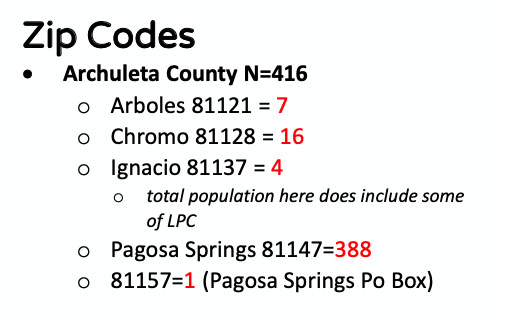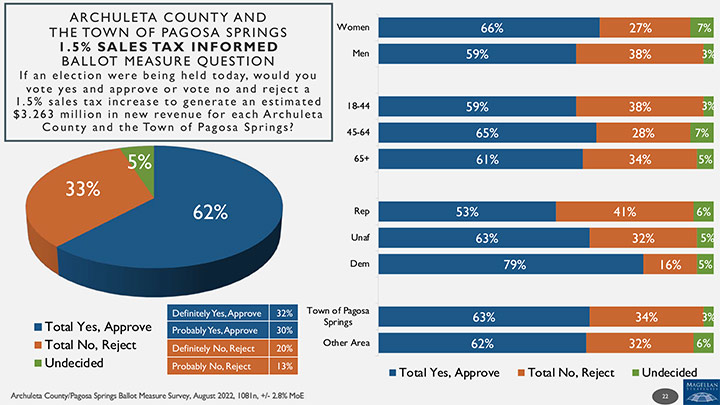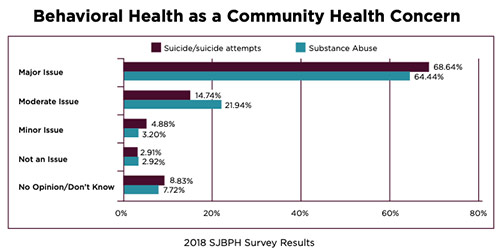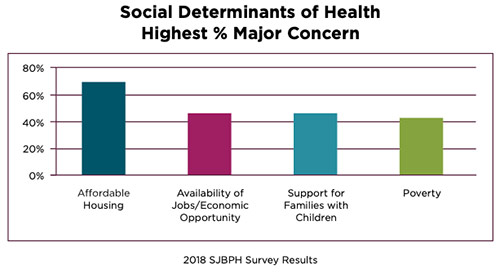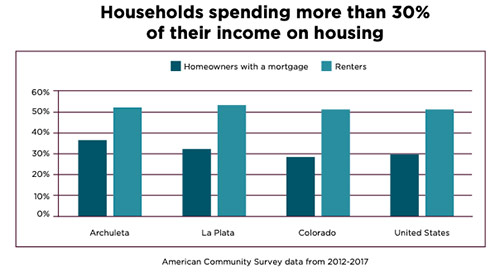The Archuleta Board of County Commissioners got a dose of data-related explanations on April 18, when Adrian Uzunian, Director of Public Health Innovation at San Juan Basin Public Health, presented a brief summary of the recent community survey conducted by SJBPH as part of its five-year Community Health Assessment. SJBPH has been conducting a Community Health Assessment every five years, in conjunction with a Public Health Improvement Plan.
The BOCC may have a special interest in this particular 2023 assessment, considering that Archuleta County is preparing to stand up a County Public Health Department at the end of the year, to replace SJBPH, which will be disbanded.
But of course, I am asking — in this editorial series — whether data has the significance that data salesmen give it. Because very few people seem to be asking that question.
According to Mr. Robinson’s slide show, 90% of the world’s data has been created in the past two years, and only 0.5% of the world’s data has been analyzed.
In Mr. Uzunian’s graphic, the 0.5% was shown in the European format, using a ‘decimal comma’ instead of a ‘decimal point’…
…So I assume SJBPH borrowed the graphic from a European source.
It would appear, then, that 99.5% of the data produced in the past 500 years has not yet been analyzed. At this rate, we are getting further and further behind on the analysis work, with each passing day. We are generating data that will never be converted into a useful form.
Mr. Uzunian then proceeded to summarize some very preliminary data from SJBPH’s 2023 community survey. He noted that only 416 responses had come from Archuleta County, out of a population of about 14,000 people.
“That’s not a very big number, but actually the target we had for Archuleta County was a minimum of 385. And that’s just because when you get to that number, you get to a Margin of Error about 5%, so you can be reasonably confident in the results you get from that number… so, a real target for us for Archuleta County, so we could feel good about the results.”
I do wonder whether we should feel good about the data.
For example…
…the 2022 survey of likely Archuleta County voters, conducted by Magellan Strategies, had responses from 1,081 people — nearly three times the number of county residents surveyed by SJBPH. Based on that response rate, Magellan claimed a Margin of Error of 2.8%.
In that survey, 62% of the respondents said they would “Definitely” or “Probably” vote in favor of a $6.5 million sales tax increase.
When the ballots were counted, only about 27% of the voters had voted “Yes”.
That’s a “Margin of Error” of more than 100%, according to my pocket calculator. Ouch.
But let’s get back to Mr. Robinson’s SJBPH survey. 71% of the respondents identified as female. That aligns with my statement, in a recent editorial, that women seem much more interested in the development of the future Archuleta County Public Health Department than do men. But it also indicates a ‘not-exactly-representative’ sample.
The median age of the SJBPH respondents was 59 years. That’s a somewhat older median age that what was reported recently by the Census Bureau: 50 years. We might expect older people — with their accumulating health issues — to be more interested in a public health survey. But it likewise indicates a ‘not-exactly-representative’ sample.
About 76% of the SJBPH respondents claimed a college degree. The Census puts the percentage of Archuleta County college degree holders at 40%. Once again, a ‘not-exactly-representative’ sample.
The survey is, however, only part of the ‘data’ that SJBPH is collecting. Additional information about the health of the community will reportedly come from focus groups, and from one-on-one interviews with “Key Informants”. (Seven interviews have been completed thus far.) All the data will be crunched by the Colorado School of Public Health. (By students?)
Presumably, more than 0.5% of the data will be analyzed.
As mentioned, SJBPH has been doing a Community Health Assessment about every five years. The assessment done in 2018 did not, of course, foresee the COVID crisis that arrived in 2020 and completely changed the priorities at SJBPH. You can download the 2018 assessment here.
Looking through the 2018 assessment, I saw that some of the ‘data sets’ (31) came from a local survey, but almost as many ‘data sets’ (26) were drawn from state or federal data. The local data appeared to be generally ‘anecdotal’… by which I mean, local people asked to express opinions about health — but those opinions don’t seem (to me) to have any real significance beyond ‘generally unsupported opinions by non-expert citizens’.
For example.
SJBPH asked respondents to give their opinion of the “overall health of the community”:
A few hundred people who may have vague ideas about what ‘a healthy community’ means… in two counties with a total population of about 70,000 people? Did the respondents have even a vague idea about how many of their neighbors may, or may not, be struggling with health issues?
What does this ‘data’ mean? Not a whole lot? Honestly, I would call it ‘relatively meaningless’.
Another example.
SJBPH asked its survey respondents to share their feelings about suicide and substance abuse. Are they concerned?
In 2018, slightly less than 70% of the respondents were concerned about suicide, and classified it as a “Major Issue”, along with substance abuse. Possibly, the respondents had been reading about La Plata County’s frightening suicide rate, which was three times the national average in 2017.
Did SJBPH really get any useful information by asking local respondents if they were concerned about suicide? I wonder. Certainly, SJBPH was well aware of the problem already, and in fact, has since become involved in a pilot suicide prevention program involving six Colorado public health districts. That program will be assessed for efficacy in 2024.
SJBPH also asked respondents about “social determinants” that have an impact on health outcomes.
The most pressing problem, in the opinion of the respondents, was housing. About 70% of the respondents were concerned about housing.
These were just opinions, of course, based (I would assume) on generally vague ideas about social conditions.
SJBPH also included, in their report, some specific data collected by the federal government, indicating that we have a massive housing problem, not just in Archuleta County and La Plata County, but all across the state and nation. Everywhere, a majority (more than 50%) of renters are ‘cost burdened’ by housing costs.
Landlords, meanwhile, are making out like bandits.
This was in 2018.
Has SJBPH done anything, since 2018, to address this health-related problem? I wonder.



